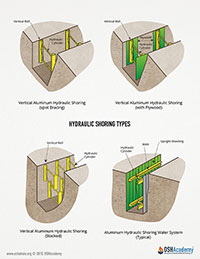Shoring Types
Shoring is the part of a support system for trench faces. It is used to prevent movement of soil, underground utilities, roadways and foundations. Shoring or shielding is used when the location or depth of the cut makes sloping back to the maximum allowable slope impractical. Shoring consists of posts, struts and sheeting. There are two types of shoring: timber and aluminum hydraulic.
Hydraulic Shoring
Hydraulic shoring, a pre-fabricated strut and/or wale system made from aluminum or steel. Hydraulic shoring provides a critical safety advantage over timber shoring because workers do NOT have to enter the trench to install or remove hydraulic shoring.
Other advantages to most hydraulic systems include:
- light enough to be installed by one worker
- gauge-regulated to ensure even distribution of pressure along the trench line
- can have their trench faces "pre-loaded" to use the soil's natural cohesion to prevent movement
- can be adapted easily to various trench depths and widths
All shoring should be installed from the top down and removed from the bottom up. Hydraulic shoring should be checked at least once per shift for leaking hoses and/or cylinders, broken connections, cracked nipples, bent bases, and other damaged or defective parts.
Pneumatic Shoring
Pneumatic shoring works in a manner similar to hydraulic shoring. The primary difference is pneumatic shoring uses air pressure in place of hydraulic pressure. However, you need to have an air compressor on site when using pneumatic shoring. Air shoring involves using compressed air instead of hydraulic fluid to expand the trench jacks into position. Using the air type of system, pins are put in place to lock the jacks when a desired level of stability is achieved. To remove this type of trenching system, air is injected into the jacks to extend them. This allows the pin to be removed. These types of jacks are popular since they are cleaner than hydraulic jacks and there isn't a danger from the leakage of fluids or other lubrication.
Knowledge Check Choose the best answer for the question.
2-8. Why does hydraulic shoring provide a critical safety advantage over timber shoring?
You forgot to answer the question!

